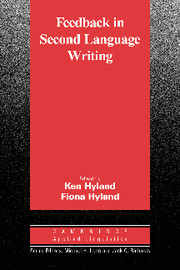Book contents
- Frontmatter
- Contents
- Contributors
- Series editors' preface
- Preface
- Chapter 1 Contexts and issues in feedback on L2 writing: An introduction
- I SITUATING FEEDBACK: SOCIOCULTURAL DIMENSIONS
- II SHAPING FEEDBACK: DELIVERY AND FOCUS DIMENSIONS
- Chapter 5 Does error feedback help student writers? New evidence on the short- and long-term effects of written error correction
- Chapter 6 Electronic feedback and second language writing
- Chapter 7 Resource-rich Web-based feedback: Helping learners become independent writers
- Chapter 8 Feedback in portfolio-based writing courses
- Chapter 9 Students and research: Reflective feedback for I-Search papers
- III NEGOTIATING FEEDBACK: INTERPERSONAL AND INTERACTIONAL DIMENSIONS
- Author index
- Subject index
Chapter 6 - Electronic feedback and second language writing
Published online by Cambridge University Press: 05 October 2012
- Frontmatter
- Contents
- Contributors
- Series editors' preface
- Preface
- Chapter 1 Contexts and issues in feedback on L2 writing: An introduction
- I SITUATING FEEDBACK: SOCIOCULTURAL DIMENSIONS
- II SHAPING FEEDBACK: DELIVERY AND FOCUS DIMENSIONS
- Chapter 5 Does error feedback help student writers? New evidence on the short- and long-term effects of written error correction
- Chapter 6 Electronic feedback and second language writing
- Chapter 7 Resource-rich Web-based feedback: Helping learners become independent writers
- Chapter 8 Feedback in portfolio-based writing courses
- Chapter 9 Students and research: Reflective feedback for I-Search papers
- III NEGOTIATING FEEDBACK: INTERPERSONAL AND INTERACTIONAL DIMENSIONS
- Author index
- Subject index
Summary
The rapid growth of educational technologies creates a broad spectrum of ways in which technology can be integrated into classroom instruction. These multiplying points of contact between technology and second language writing converge in the concept of electronic feedback.Writers who are linked to the screen are connected as well to the certainty of receiving some form of reply, whether that feedback comes as an e-mail note about favorite movies from a distant key pal, as an evaluation generated by an automated essay processing algorithm that performs high-stakes writing assessments, or as a compendium of comments from a class peer helping to make final revisions on an academic essay. Instructors can find it difficult, however, to choose from the variety of different pedagogical approaches and recommendations made by researchers. This chapter, by examining the latest developments in electronic feedback and the associated research, aims to help practitioners understand the issues and make a more focused and informed choice.
As we demonstrate, electronic feedback is a slippery term that covers a range of often dissimilar approaches to the teaching of writing. Just as the purposes of literacy take on different meanings and uses in a range of contexts, so do the uses of technology come to bear in a variety of ways depending on the research lens and pedagogical frame. For those who teach writing mainly as mastery of a compendium of subskills, electronic feedback often refers to automated feedback provided by a computer.
- Type
- Chapter
- Information
- Feedback in Second Language WritingContexts and Issues, pp. 105 - 122Publisher: Cambridge University PressPrint publication year: 2006
- 45
- Cited by

